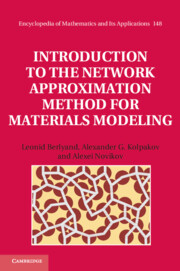Book contents
- Frontmatter
- Contents
- Preface
- 1 Review of mathematical notions used in the analysis of transport problems in densely-packed composite materials
- 2 Background and motivation for the introduction of network models
- 3 Network approximation for boundary-value problems with discontinuous coefficients and a finite number of inclusions
- 4 Numerics for percolation and polydispersity via network models
- 5 The network approximation theorem for an infinite number of bodies
- 6 Network method for nonlinear composites
- 7 Network approximation for potentials of bodies
- 8 Application of the method of complex variables
- References
- Index
6 - Network method for nonlinear composites
Published online by Cambridge University Press: 05 February 2013
- Frontmatter
- Contents
- Preface
- 1 Review of mathematical notions used in the analysis of transport problems in densely-packed composite materials
- 2 Background and motivation for the introduction of network models
- 3 Network approximation for boundary-value problems with discontinuous coefficients and a finite number of inclusions
- 4 Numerics for percolation and polydispersity via network models
- 5 The network approximation theorem for an infinite number of bodies
- 6 Network method for nonlinear composites
- 7 Network approximation for potentials of bodies
- 8 Application of the method of complex variables
- References
- Index
Summary
In this chapter we explain how to construct a discrete network for nonlinear high-contrast densely-packed composites. We use this presentation to demonstrate the so-called perforated medium technique in the analysis of high-contrast composites. We also use this investigation to demonstrate how the discrete network approximation arises from the interplay between geometry and asymptotic analysis. More specifically, the key mathematical feature of partial differential equations that describe high-contrast densely-packed composites is that their solutions exhibit asymptotically singular behavior, when particles are close to touching (high concentration). The singularities of the solutions occur exactly in the necks between almost touching particles. The location of these singularities can be characterized naturally by the geometric patterns of the distribution of the particles in the materials. Thus a geometric construction of a network is completely natural. As it is illustrated in this book, a rigorous mathematical justification is based on geometric and asymptotic arguments. These two arguments are coupled together. As a result, most of the constructions of asymptotic discrete network approximations for high-contrast composites are complicated, thus they are not attractive for practitioners. It is possible, however, to separate the geometric and the asymptotic arguments. It makes the construction of the network more transparent, and allows us to strengthen some of the previous results. In particular, it turns out that the validity of discrete network approximations could be verified for a class of composites, which is larger than the one that satisfies the δ-N close-packing condition.
- Type
- Chapter
- Information
- Publisher: Cambridge University PressPrint publication year: 2012



